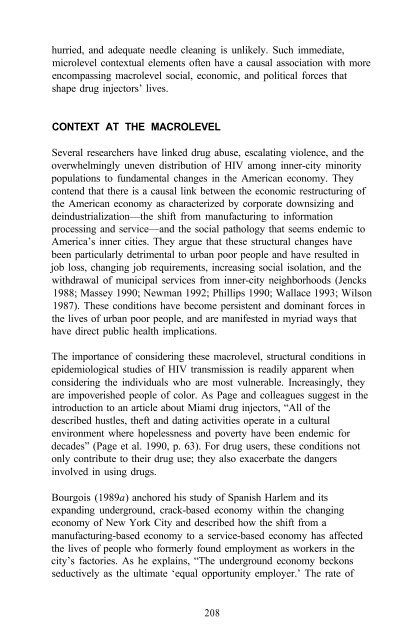The Context of HIV Risk Among Drug Users and Their Sexual Partners
The Context of HIV Risk Among Drug Users and Their Sexual Partners
The Context of HIV Risk Among Drug Users and Their Sexual Partners
Create successful ePaper yourself
Turn your PDF publications into a flip-book with our unique Google optimized e-Paper software.
hurried, <strong>and</strong> adequate needle cleaning is unlikely. Such immediate,<br />
microlevel contextual elements <strong>of</strong>ten have a causal association with more<br />
encompassing macrolevel social, economic, <strong>and</strong> political forces that<br />
shape drug injectors’ lives.<br />
CONTEXT AT THE MACROLEVEL<br />
Several researchers have linked drug abuse, escalating violence, <strong>and</strong> the<br />
overwhelmingly uneven distribution <strong>of</strong> <strong>HIV</strong> among inner-city minority<br />
populations to fundamental changes in the American economy. <strong>The</strong>y<br />
contend that there is a causal link between the economic restructuring <strong>of</strong><br />
the American economy as characterized by corporate downsizing <strong>and</strong><br />
deindustrialization—the shift from manufacturing to information<br />
processing <strong>and</strong> service—<strong>and</strong> the social pathology that seems endemic to<br />
America’s inner cities. <strong>The</strong>y argue that these structural changes have<br />
been particularly detrimental to urban poor people <strong>and</strong> have resulted in<br />
job loss, changing job requirements, increasing social isolation, <strong>and</strong> the<br />
withdrawal <strong>of</strong> municipal services from inner-city neighborhoods (Jencks<br />
1988; Massey 1990; Newman 1992; Phillips 1990; Wallace 1993; Wilson<br />
1987). <strong>The</strong>se conditions have become persistent <strong>and</strong> dominant forces in<br />
the lives <strong>of</strong> urban poor people, <strong>and</strong> are manifested in myriad ways that<br />
have direct public health implications.<br />
<strong>The</strong> importance <strong>of</strong> considering these macrolevel, structural conditions in<br />
epidemiological studies <strong>of</strong> <strong>HIV</strong> transmission is readily apparent when<br />
considering the individuals who are most vulnerable. Increasingly, they<br />
are impoverished people <strong>of</strong> color. As Page <strong>and</strong> colleagues suggest in the<br />
introduction to an article about Miami drug injectors, “All <strong>of</strong> the<br />
described hustles, theft <strong>and</strong> dating activities operate in a cultural<br />
environment where hopelessness <strong>and</strong> poverty have been endemic for<br />
decades” (Page et al. 1990, p. 63). For drug users, these conditions not<br />
only contribute to their drug use; they also exacerbate the dangers<br />
involved in using drugs.<br />
Bourgois (1989a) anchored his study <strong>of</strong> Spanish Harlem <strong>and</strong> its<br />
exp<strong>and</strong>ing underground, crack-based economy within the changing<br />
economy <strong>of</strong> New York City <strong>and</strong> described how the shift from a<br />
manufacturing-based economy to a service-based economy has affected<br />
the lives <strong>of</strong> people who formerly found employment as workers in the<br />
city’s factories. As he explains, “<strong>The</strong> underground economy beckons<br />
seductively as the ultimate ‘equal opportunity employer.’ <strong>The</strong> rate <strong>of</strong><br />
208
















